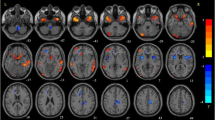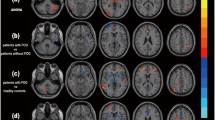Abstract
Purpose
The symptom-specific intrinsic neural mechanisms underlying Parkinson's disease (PD) subtypes (tremor dominant [TD] and postural instability gait difficulty [PIGD]) remain unclarified. We examined spontaneous brain activity patterns in TD and PIGD.
Material and methods
We included 49 patients with PD (21 with TD/28 with PIGD) and 32 healthy controls (HCs) in this study. We conducted analysis of variance and post-hoc analyses of the amplitude of low-frequency fluctuation (ALFF) and regional homogeneity (ReHo) values of the three groups, with age, sex, and gray matter volume as covariates, and a relationship analysis of the ALFF and ReHo values with clinical variables.
Results
In comparison with HCs, PIGD PD patients had increased ALFF values in the right middle occipital gyrus and left superior occipital gyrus and decreased values primarily in the bilateral inferior frontal gyrus (triangular part). TD PD patients had lower ALFF values in the right inferior frontal gyrus (triangular part) and left insula. In comparison to TD PD patients, PIGD PD patients had higher ALFF values in the left middle occipital gyrus and left superior occipital gyrus. In contrast to HCs, TD PD patients demonstrated a reduction of ReHo values in the left middle temporal gyrus, and PIGD patients showed a decrease of ReHo values in the left inferior temporal gyrus.
Conclusion
ALFF values increased in the occipital gyrus of the PIGD PD patients, thus providing evidence of a compensatory mechanism of altered motor function in comparison with the TD PD patients.





Similar content being viewed by others
References
Nutt JG (2016) Motor subtype in Parkinson’s disease: different disorders or different stages of disease? Mov Disord 31(7):957–961. https://doi.org/10.1002/mds.26657
Qian E, Huang Y (2019) Subtyping of Parkinson’s disease - where are we up to? Aging Dis 10(5):1130–1139. https://doi.org/10.14336/AD.2019.0112
Konno T, Deutschländer A, Heckman MG, Ossi M, Vargas ER, Strongosky AJ, van Gerpen JA, Uitti RJ, Ross OA, Wszolek ZK (2018) Comparison of clinical features among Parkinson’s disease subtypes: a large retrospective study in a single center. J Neurol Sci 386:39–45. https://doi.org/10.1016/j.jns.2018.01.013
Mohl B, Berman BD, Shelton E, Tanabe J (2017) Levodopa response differs in Parkinson’s motor subtypes: a task-based effective connectivity study. J Comp Neurol 525(9):2192–2201. https://doi.org/10.1002/cne.24197
van der Heeden JF, Marinus J, Martinez-Martin P, Rodriguez-Blazquez C, Geraedts VJ, van Hilten JJ (2016) Postural instability and gait are associated with severity and prognosis of Parkinson disease. Neurology 86(24):2243–2250. https://doi.org/10.1212/WNL.0000000000002768%JNeurology
Tian Y, Chen H-B, Ma X-X, Li S-H, Li C-M, Wu S-H, Liu F-Z, Du Y, Li K, Su W (2022) Aberrant volume-wise and voxel-wise concordance among dynamic intrinsic brain activity indices in Parkinson’s disease: a resting-state fMRI study. Front Aging Neurosci 14:814893. https://doi.org/10.3389/fnagi.2022.814893
Fox MD, Raichle ME (2007) Spontaneous fluctuations in brain activity observed with functional magnetic resonance imaging. Nat Rev Neurosci 8(9):700–711. https://doi.org/10.1038/nrn2201
Stebbins GT, Goetz CG, Burn DJ, Jankovic J, Khoo TK, Tilley BC (2013) How to identify tremor dominant and postural instability/gait difficulty groups with the movement disorder society unified Parkinson’s disease rating scale: comparison with the unified Parkinson’s disease rating scale. Mov Disord 28(5):668–670. https://doi.org/10.1002/mds.25383
Hou Y, Luo C, Yang J, Ou R, Song W, Wei Q, Cao B, Zhao B, Wu Y, Shang H-F, Gong Q (2016) Prediction of individual clinical scores in patients with Parkinson’s disease using resting-state functional magnetic resonance imaging. J Neurol Sci 366:27–32. https://doi.org/10.1016/j.jns.2016.04.030
Cordes D, Haughton VM, Arfanakis K, Carew JD, Turski PA, Moritz CH, Quigley MA, Meyerand ME (2001) Frequencies contributing to functional connectivity in the cerebral cortex in “resting-state” data. AJNR Am J Neuroradiol 22(7):1326–1333
Song X-W, Dong Z-Y, Long X-Y, Li S-F, Zuo X-N, Zhu C-Z, He Y, Yan C-G, Zang Y-F (2011) REST: a toolkit for resting-state functional magnetic resonance imaging data processing. PLoS ONE 6(9):e25031. https://doi.org/10.1371/journal.pone.0025031
Zang Y, Jiang T, Lu Y, He Y, Tian L (2004) Regional homogeneity approach to fMRI data analysis. Neuroimage 22(1):394–400. https://doi.org/10.1016/j.neuroimage.2003.12.030
Ashburner J (2007) A fast diffeomorphic image registration algorithm. Neuroimage 38(1):95–113
Helmich RC, de Lange FP, Bloem BR, Toni I (2007) Cerebral compensation during motor imagery in Parkinson’s disease. Neuropsychologia 45(10):2201–2215. https://doi.org/10.1016/j.neuropsychologia.2007.02.024
Lewis GN, Byblow WD, Walt SE (2000) Stride length regulation in Parkinson’s disease: the use of extrinsic, visual cues. Brain 123(Pt 10):2077–2090. https://doi.org/10.1093/brain/123.10.2077
Okuma Y, Yanagisawa N (2008) The clinical spectrum of freezing of gait in Parkinson’s disease. Mov Disord 23(Suppl 2):S426–S430. https://doi.org/10.1002/mds.21934
Hu X-F, Zhang J-Q, Jiang X-M, Zhou C-Y, Wei L-Q, Yin X-T, Li J, Zhang Y-L, Wang J (2015) Amplitude of low-frequency oscillations in Parkinson’s disease: a 2-year longitudinal resting-state functional magnetic resonance imaging study. Chin Med J (Engl) 128(5):593–601. https://doi.org/10.4103/0366-6999.151652
Davidsdottir S, Cronin-Golomb A, Lee A (2005) Visual and spatial symptoms in Parkinson’s disease. Vision Res 45(10):1285–1296. https://doi.org/10.1016/j.visres.2004.11.006
Uc EY, Rizzo M, Anderson SW, Qian S, Rodnitzky RL, Dawson JD (2005) Visual dysfunction in Parkinson disease without dementia. Neurology 65(12):1907–1913. https://doi.org/10.1212/01.wnl.0000191565.11065.11
Tessitore A, Amboni M, Cirillo G, Corbo D, Picillo M, Russo A, Vitale C, Santangelo G, Erro R, Cirillo M, Esposito F, Barone P, Tedeschi G (2012) Regional gray matter atrophy in patients with Parkinson disease and freezing of gait. AJNR Am J Neuroradiol 33(9):1804–1809. https://doi.org/10.3174/ajnr.A3066
Göttlich M, Münte TF, Heldmann M, Kasten M, Hagenah J, Krämer UM (2013) Altered resting state brain networks in Parkinson’s disease. PLoS ONE 8(10):e77336. https://doi.org/10.1371/journal.pone.0077336
Zhao Y, Zheng X, Wang Q, Xu J, Xu X, Zhang M (2014) Altered activation in visual cortex: unusual functional magnetic resonance imaging finding in early Parkinson’s disease. J Int Med Res 42(2):503–515. https://doi.org/10.1177/0300060513507647
Wang Z, Chen H, Ma H, Ma L, Wu T, Feng T (2016) Resting-state functional connectivity of subthalamic nucleus in different Parkinson’s disease phenotypes. J Neurol Sci 371:137–147. https://doi.org/10.1016/j.jns.2016.10.035
Wang Z, Liu Y, Ruan X, Li Y, Li E, Zhang G, Li M, Wei X (2020) Aberrant amplitude of low-frequency fluctuations in different frequency bands in patients with Parkinson’s disease. Front Aging Neurosci 12:576682. https://doi.org/10.3389/fnagi.2020.576682
Shibahara I, Sato S, Hide T, Saito R, Kanamori M, Sonoda Y, Tominaga T, Kumabe T (2021) Postcentral gyrus resection of opercular gliomas is a risk factor for motor deficits caused by damaging the radiologically invisible arteries supplying the descending motor pathway. Acta Neurochir 163(5):1269–1278. https://doi.org/10.1007/s00701-021-04737-y
Liu Y, Li M, Chen H, Wei X, Hu G, Yu S, Ruan X, Zhou J, Pan X, Li Z, Luo Z, Xie Y (2019) Alterations of regional homogeneity in Parkinson’s disease patients with freezing of gait: a resting-state fMRI study. Front Aging Neurosci 11:276. https://doi.org/10.3389/fnagi.2019.00276
Pan P, Zhan H, Xia M, Zhang Y, Guan D, Xu Y (2017) Aberrant regional homogeneity in Parkinson’s disease: a voxel-wise meta-analysis of resting-state functional magnetic resonance imaging studies. Neurosci Biobehav Rev 72:223–231. https://doi.org/10.1016/j.neubiorev.2016.11.018
Weil RS, Schrag AE, Warren JD, Crutch SJ, Lees AJ, Morris HR (2016) Visual dysfunction in Parkinson’s disease. Brain 139(11):2827–2843. https://doi.org/10.1093/brain/aww175
Hou Y, Ou R, Yang J, Song W, Gong Q, Shang H (2018) Patterns of striatal and cerebellar functional connectivity in early-stage drug-naïve patients with Parkinson’s disease subtypes. Neuroradiology 60(12):1323–1333. https://doi.org/10.1007/s00234-018-2101-6
Xiong Y, Han D, He J, Zong R, Bian X, Duan C, Zhang D, Zhou X, Pan L, Lou X (2022) Correlation of visual area with tremor improvement after MRgFUS thalamotomy in Parkinson’s disease. J Neurosurg 136(3):681–688. https://doi.org/10.3171/2021.3.JNS204329
Shi J, Huang H, Jiang R, Mao X, Huang Q, Li A (2022) The right inferior frontal gyrus plays an important role in unconscious information processing: activation likelihood estimation analysis based on functional magnetic resonance imaging. Front Neurosci 16:781099. https://doi.org/10.3389/fnins.2022.781099
Goelman G, Dan R, Růžička F, Bezdicek O, Jech R (2021) Asymmetry of the insula-sensorimotor circuit in Parkinson’s disease. Eur J Neurosci 54(6):6267–6280. https://doi.org/10.1111/ejn.15432
Xu J, Zhang J, Wang J, Li G, Hu Q, Zhang Y (2016) Abnormal fronto-striatal functional connectivity in Parkinson’s disease. Neurosci Lett 613:66–71. https://doi.org/10.1016/j.neulet.2015.12.041
Fathy YY, Hoogers SE, Berendse HW, van der Werf YD, Visser PJ, de Jong FJ, van de Berg WDJ (2020) Differential insular cortex sub-regional atrophy in neurodegenerative diseases: a systematic review and meta-analysis. Brain Imaging Behav 14(6):2799–2816. https://doi.org/10.1007/s11682-019-00099-3
Zhang Z, Liu L, Li Y, Tan T, Niki K, Luo J (2020) The function of medial temporal lobe and posterior middle temporal gyrus in forming creative associations. Hippocampus 30(12):1257–1267. https://doi.org/10.1002/hipo.23253
Jubault T, Gagnon J-F, Karama S, Ptito A, Lafontaine A-L, Evans AC, Monchi O (2011) Patterns of cortical thickness and surface area in early Parkinson’s disease. Neuroimage 55(2):462–467. https://doi.org/10.1016/j.neuroimage.2010.12.043
Carbon M, Felice Ghilardi M, Dhawan V, Eidelberg D (2007) Correlates of movement initiation and velocity in Parkinson’s disease: a longitudinal PET study. Neuroimage 34(1):361–370
Drummond SP, Brown GG, Salamat JS, Gillin JC (2004) Increasing task difficulty facilitates the cerebral compensatory response to total sleep deprivation. Sleep 27(3):445–451
Thomas RJ (2005) Fatigue in the executive cortical network demonstrated in narcoleptics using functional magnetic resonance imaging–a preliminary study. Sleep Med 6(5):399–406
Joo EY, Jeon S, Lee M, Kim ST, Yoon U, Koo DL, Lee J-M, Hong SB (2011) Analysis of cortical thickness in narcolepsy patients with cataplexy. Sleep 34(10):1357–1364. https://doi.org/10.5665/SLEEP.1278
Acknowledgements
None
Funding
This study has received funding from the National Natural Science Foundation of China (grant number 82151309, 81825012).
Author information
Authors and Affiliations
Contributions
All authors contributed to the study conception and design. Material preparation, data collection and analysis were performed by XL and CY. The first draft of the manuscript was written by YL and all authors commented on previous versions of the manuscript. All authors read and approved the final manuscript.
Corresponding author
Ethics declarations
Conflict of interest
The authors of this manuscript declare no relationships with any companies, whose products or services may be related to the subject matter of the article.
Ethical approval
The study design was approved by the appropriate ethics review board of Chinese PLA General Hospital.
Human or animal rights
This article does not contain any studies with human participants or animals performed by any of the authors.
Informed consent
We declare that all study participants provided informed consent.
Additional information
Publisher's Note
Springer Nature remains neutral with regard to jurisdictional claims in published maps and institutional affiliations.
Rights and permissions
Springer Nature or its licensor (e.g. a society or other partner) holds exclusive rights to this article under a publishing agreement with the author(s) or other rightsholder(s); author self-archiving of the accepted manuscript version of this article is solely governed by the terms of such publishing agreement and applicable law.
About this article
Cite this article
Lan, Y., Liu, X., Yin, C. et al. Resting-state functional magnetic resonance imaging study comparing tremor-dominant and postural instability/gait difficulty subtypes of Parkinson’s disease. Radiol med 128, 1138–1147 (2023). https://doi.org/10.1007/s11547-023-01673-y
Received:
Accepted:
Published:
Issue Date:
DOI: https://doi.org/10.1007/s11547-023-01673-y




